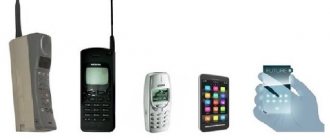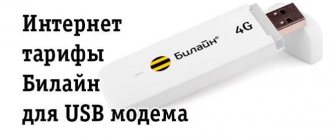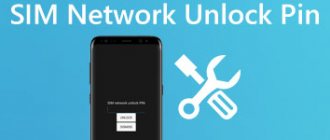When using a mobile phone, few people think about how calls are made and where the Internet comes from. In fact, everything is not as simple as you might think. There are specialized cellular communication standards - this is a general designation for all technologies that are used to create mobile communications. Some of these standards are similar to each other. Standards are created in a similar way and have almost the same characteristics. Based on the parameters, all standards are divided into groups called generations. This is where the well-known designations 1G, 2G, 3G and 4G come from. The letter G in this case is an abbreviation for the English word generation. You will also learn how cellular communications developed and what fundamental differences exist between its generations.
GSM History of the standard
The name GSM was originally an acronym for the group that led the development of this standard. Later its meaning was interpreted in the right way and came to mean the Global System for Mobile Communications. In 1982, the creation of GSM began. It was conducted by a coalition of 26 European companies providing communications services. The goal was to unite all European countries with a single communications standard that would operate at 900 megahertz. 7 years later, ETSI continued to work on the development of GSM. The standard began to fully operate only in mid-1991. At the same time, he completely bypassed his closest competitors, such as the North American PCS. After this, the standard was improved in 1993. Afterwards, only improvements were made to the current version.
What is WCDMA
Cellular WCDMA, which is an abbreviation for Code Division Multiple Access or Wideband CDMA, is a mobile phone standard that combines CDMA and GSM to create an entirely new system .
This is one of the most important attributes when it comes to the third generation mobile network (3G mobile phone technology). Although the term WCDMA is often used interchangeably with UMTS (Universal Mobile Telecommunications Systems), this is technically incorrect since WCDMA is just an example of UMTS
Tele2 4G - coverage area, tariffs and Internet speed
First generation of mobile communications (1G)
This generation used analog standards in its work, which were introduced during the 1980s. Subsequently, they were replaced by 2G digital technology, which was superior to the first generation in all respects. The fundamental difference between them is the ability to use SMS and encrypt calls: only a digital standard can allow this. In total, 1G supported more than 10 standards. The most famous of them: NMT, AMPS, TACS, C-450, RtMI. All of them were used separately, depending on the region of application. The download speed when using 1G did not exceed 5.6 kilobytes per second, which is simply ridiculous by today's standards.
GSM voice codecs
GSM uses voice codecs to match 3.1 kHz audio at the maximum data rate in GSM frequency bands. The original codecs used by the GSM standard were Full Rate (13 kbit/s) and Half Rate (6.5 kbit/s). Each of them used a system based on LPC (linear predictive coding). These codecs helped bring maximum efficiency to the bitrate, while also making it possible to prioritize and protect more important components of the transmitted audio signal.
In 1997, the EFR codec was published and implemented in the GSM standard. EFR provided a 12.2k/sec GSM network and used a full-speed channel. Once UMTS was developed, EFR evolved into AMR-Narrowband CODEC, which is more resistant to interference and is considered superior to legacy GSM codecs.
Characteristics of analog cellular communication standards
The main analogue networks used frequencies of 450, 800 and 900 megahertz. Radiocom 2000, the standard used in France, stands out: it used the 170, 200 and 400 MHz bands.
All analog standards used frequency modulation to transmit raw data. To operate according to these standards, a mobile station had to have relatively high power - from three to five watts. The main disadvantage of these standards lies in their low capacity, which appears due to the incomplete efficiency of using a dedicated band operating at a frequency of 12.5-30 kilohertz. This entailed high efficiency losses and increased energy consumption.
What other network modes are there?
There are several more network modes:
- TDMA (Time Division Multiple Access). This is a channel access method for public networks. It allows multiple people to simultaneously use the same frequency channel by splitting the signal into different time periods. Users send data in quick succession, one after another, using their own time frame. This allows multiple stations to share the same sending medium (such as an RF channel) while using only a portion of the channel's capacity. TDMA is used in 2G digital mobile cellular systems such as GSM, PDC and the iDEN standard.
- EVDO (Evolution-Data Optimized or Evolution-Data Only). It is a telecommunications standard for sending data packets wirelessly over radio signals, typically for broadband Internet access. It uses multiplexing techniques including Code Division Multiple Access (CDMA) as well as Time Division Multiplexing (TDM) to maximize individual user throughput and overall system throughput. The standard has been adopted by many mobile service providers around the world, especially those that previously used CDMA networks. EVDO was designed as an evolution of the CDA2000 standard that will support high data rates and can be deployed alongside wireless operator voice services.
- UMTS (Universal Mobile Telecommunications System). This is a third generation mobile standard. Works with GSM-based networks. Created by 3GPP (3rd Generation Partnership Project), UMTS belongs to the standard set of the international standard IMT-2000. It is often compared to the CDMA2000 mode, designed for networks running on competing cdmaOne technology. UMTS uses wideband code division multiple access (W-CDMA) technology to guarantee greater spectral efficiency and capacity for mobile network operators.
- HSPA+ , or Enhanced High Speed Packet Access. HSPA or HSPA+ is a technical standard for wireless broadband communications. HSPA+ extends widespread WCDMA-based 3G networks with faster end-user speeds that are comparable to newer LTE networks. HSPA+ was first defined in the 3GPP technical standard version 7 and expanded further in subsequent releases. HSPA+ is the evolution of high-speed packet access and provides data transfer rates of up to 168 megabits per second (Mbps) to the mobile device and 22 Mbps from the mobile device.
- LTE "Long Term Evolution". This is the generally accepted 4G wireless standard. All US providers use it. While most phones in 2021 use LTE for data, US manufacturer Sprint's devices still use CDMA for all voice calls, and Verizon still has a network list for phones that will work on its network.
LTE frequencies and bands in Russia
Second generation of mobile communications (2G)
The introduction of new standards, which formed the second generation of mobile communications, was due to the impossibility of improving analogue standards into digital ones. In fact, 2G began its work in Europe in 1991, and by 1993, 36 GSM networks had already been created in 22 countries. The Japanese equivalent of the basic standards was introduced in 1994. At the same time, constant internal improvement of technologies was carried out to get rid of the shortcomings of the emerging standards. The introduction of 2G contributed to a significant acceleration in data transfer and the ability to communicate through short text messages.
How does the GSM security service work?
The GSM standard was designed with security in mind from the very beginning. The network was created with the ability to authenticate subscribers using a pre-public key and challenge response methodology. In GSM, the communication between the mobile handset and the base station can also be encrypted. With the development of UMTS, there is also an optional USIM (Universal Subscriber Identity Module) that provides a longer authentication key to provide increased security and also provides base station authentication to protect the user from spoofing.
There are several cryptographic algorithms used by GSM to ensure network security. The A5/1, A5/2 and A5/3 encryptors are sanctioned for over-the-air voice privacy, with A5/1 being the stronger algorithm used in Europe and the US. GSM supports the use of multiple encryption algorithms, so algorithms can be changed by network operators as stronger ones become available. GSM security issues such as service theft, privacy and legal interception continue to generate significant interest in the GSM community. More detailed information about GSM security can be found on the GSM Security Portal.
2nd generation digital cellular standards
During the transition to 2G, there were two main standards for cellular communication systems - the already mentioned GSM, used in Europe, and D-AMPS, which became widespread in North America. They were developed independently of each other. You already know the history of the formation of GSM, let’s focus on D-AMPS. Work on its creation began when it became obvious that the existing analog AMPS standard could not be completely replaced by a digital one due to the breadth of its application. But soon, they found a way to create an analog-digital system that is capable of ensuring the operation of both systems in the same frequency range. Work on this standard began in 1988 and was completed in 1992. In addition to the name D-AMPS, you may come across the abbreviation IS-54, which stands for “intermediate standard.”
Transition period (2.5G)
As technology has evolved over time, it has also become necessary to transfer data between cell phone users at significantly higher speeds. Subsequently, GPRS was created - a general packet radio receiver. GPRS is a kind of addition to the GSM standard, which allows the use of packet data transmission in the network of this standard. Payment for using GPRS is charged for the unpacked volume of traffic, and not for the time of use. The next stage in the development of GPRS was EDGE. The acronym literally stands for expanding the capabilities for the evolution of GSM. This technology has made it possible to significantly speed up the transfer of information. Sometimes EDGE is also called the 2.75 generation standard. In addition, XRTT technology was introduced, which in theory can transmit information at a speed of 144 kilobits per second, but in reality this figure rarely exceeded 60. However, this technology is still widely used, like any other that uses registered radio link.
Why do you need GSM in your phone?
At this time, GSM communications and Internet are gradually being replaced by more advanced technologies, such as WCDMA and LTE (4G). Thanks to the increased bandwidth, the available speed of sending and receiving information has increased to 3.6 Mbit/s (3G). Due to this, users have the opportunity not only to quickly download large files, but also to watch videos in high resolution. However, this pleasure cannot be called cheap, especially compared to 2G networks. Moreover, here the matter concerns not only the cost of communication, but also the additional consumption of the battery.
It is for this reason that you can configure the most convenient network mode in the smartphone settings. As a rule, the default value there is set to “Automatic”, which allows the device to adapt to the communication standard available in the current location.
If there is a need to save battery power, you can switch your smartphone to GSM mode. This will not only extend the operating time, but also improve the quality of communication if the current location has a weak 3G/4G network signal.
GSM network architecture
Let's look at an example of an ideal network model. The figure below shows a model where each BS has 6 neighbors. For example, these stations are located on a smooth surface, without hills, trees, buildings or uneven surfaces.
A base station (BS) is a transceiver station that interacts with your mobile phone via a radio channel. The coverage area of the BS under such conditions is a circle that will intersect with each other. If we connect the intersection points of the circles, we get hexagons - honeycombs.
The network is divided into 2 main systems BSS (Base Station System) - the base station subsystem and SSS - the switching system. This system includes:
| Mobile station | An ordinary smartphone that we use every day. Accordingly, it contains both a receiver and a transmitter for communication with the base station |
| Subscriber identification module (SIM card) | It is an integral part of the phone and is needed to recognize a subscriber on the network and to transmit encrypted messages. |
BSC – base station controller.
His responsibilities include:
- Distribution of radio channels between the base station and the mobile station;
- Controls the connection with the mobile station (MS);
- Notifying the MS about an incoming call;
- Monitoring the level of output radiated power between the mobile and base station during subscriber calls.
The intermediate link between the BS and the switching system is a transcoder (TCE) - this is equipment that converts the input voice and data channel signals from the switching center into a form that complies with the GSM radio interface recommendations.
Simply put, over wired lines, digital voice is sent with V=64 Kbps. The signal is transmitted at the same speed from the output of the switching center. And between the mobile station and the BS, speech is transmitted with V=13 Kbit/s. The transcoder turns 64 Kbps into 13.
Mobile Switching Center (MSC) is translated from English as mobile switching center. The switch serves a group of cells limited in area, for example in a specific city, and performs all types of connections necessary for the operation of the MS.
Switch functions:
| Connection between the MS and certain telecommunication networks (from your cell phone and switch you can reach any subscriber of the city network) |
| Manages calls and routes them |
| Responsible for the “relay pass” (handover). During this function, when the MS moves from one cell to another, continuity of communication is ensured |
| Creates the initial data required for issuing invoices for rendered communication services to the billing center |
| Registering the location of the MS. For example, when you move from the Moscow region to the Leningrad region, all these movements are recorded in the database |
Home Location Register (HLR) – “home” location register. This device contains information about the location of any of the mobile stations, which allows the switching center to send a call to that station.
HLR is a reference database (DB) about regularly registered subscribers on the network:
- User credibility parameters;
- Certain numbers;
- List of communication services provided to the client;
- Specialist. routing information;
- Registration of roaming data.
Visitor Location Register (VLR) – Visitor location register.
This is a temporary database of subscribers who are within the coverage area of a specific switching center. The primary role of the VLR is to minimize the number of requests that MSCs must make to the Home Location Register (HLR), which contains persistent data related to cellular network subscribers.
Ideally, there should be only one visitor location register per MSC, but it is also possible to have one VLR serving multiple MSCs.
The advantage of the system is that it reduces the load on the main database in the “home” location registry. It stores the same information as the home register while the subscriber is within the coverage area of a particular switching center.
Authentication Center (AUC) – authentication center. It is a function in the GSM network used to authenticate the mobile subscriber who wants to connect to the network. Authentication is accomplished by identifying and checking the validity of the SIM card.
Once the subscriber is authenticated, the AUC is responsible for generating parameters used for privacy and encrypting the radio link. To ensure the privacy of a mobile subscriber, a Temporary Mobile Subscriber Identity (TMSI) is assigned for the time during which the subscriber is controlled by a specific Mobile Switching Center (MSC) associated with the AUC.
| Determines the user's credibility |
| Includes several blocks and creates keys and authentication algorithms |
| The subscriber's rights are verified and access to the communication network is realized |
| The center has several unique numbers, an individual key and a client authentication algorithm, which are subsequently sent to the switching center |
Equipment Identity Register (EIR) – equipment identification register.
The register contains special IMEI (International Mobile Station Equipment Identity) numbers on almost all mobile stations that have access to a particular communication network.
The database is divided:
- White list – for authorized MS;
- The black list includes numbers that were stolen or denied access for any other reason;
- Gray for MS with software data problems.
The control link of the network, which is not included in the switching system, is the Operation and Maintenance Center, abbreviated as TsEiTO.
The Operation and Maintenance Center inspects and manages the remaining components of the network. In the event of an emergency, CE&TO will notify personnel and record information about the emergency. Depending on the degree of damage, compulsory medical insurance allows you to eliminate the situation automatically or with personnel intervention.
To create intelligent hierarchical management of the GSM network, the Network Management Center (NMC) is suitable - a network operations center that:
| Responsible for the use and technical service at the entire network level, with the support of regional centers |
| In case of an emergency, for example, a mechanism failure or node overload, NMC will provide traffic management on the network and network dispatch control |
| Monitors the technical condition of control nodes used in network equipment and displays the network status on monitors for network control center operators. Which allows workers to monitor the process and help operation centers |
| Personnel are responsible for monitoring one or more networks for certain conditions that may require special attention to avoid degradation of service quality |
| Organizations can manage more than one NMC, either to manage different networks or to provide geographic redundancy if one site is unavailable |
The evolution of GSM or what 2.5G and 2.75G are
GPRS (General Packet Radio Service) or 2.5G is an add-on to the GSM standard. The information in it is transmitted in the form of packets - messages containing information about the sender, recipient and transmitted data. A fragment of a photograph, for example.
Packages allow subscribers to exchange data not only among themselves, but also to send / receive from the Internet. Transmission speed – 85-100 kbit/sec.
EDGE (Enhanced Data rates for GSM Evolution) or 2.75G is an improved version of GPRS using 8PSK modulation. The technology increases the transmission speed to 270 kbit/sec.











